In recent years decentralized solar energy systems have gained increasing attention as these offer several benefits compared to centralized generation systems. They have a short gestation time and can contribute to meeting the growing electricity demand in India.
Well-planned siting of distributed solar energy generation can reap technical and commercial benefits. For example, locating it near the load centres reduces transmission and distribution losses (T&D) losses and also defers or avoids infrastructure upgrade costs while lowering the cost of supply (CoS).
Despite the benefits of distributed solar energy generation, achieving high solar penetrations presents grid operators with challenges associated with solar energy’s intermittent nature.
A recently published report by Auroville Consulting assesses the techno-commercial impact of high solar energy penetration on the distribution network. The study was undertaken on ten feeders of a selected substation in the Erode district of Tamil Nadu.
The approach taken may be best described as considering the selected distribution network as an energy island – one that remains interconnected to the larger grid, draws services from it, and in turn, provides services to it.
The objective was to explore what it takes to develop a net-zero energy distribution network by introducing distributed solar energy, Time-of-Day (ToD) tariffs and energy storage solutions, wherein 100% of the annual electricity demand is met from local solar energy generation.
The solar energy generators were interconnected at existing high-tension (HT) feeders to optimize the utilization of existing distribution infrastructure assets and to reduce T&D losses.
This approach deviates from the current emphasis that solar energy generators require a dedicated feeder—as is promoted, for example, under KUSUM-Scheme A by the Ministry of New and Renewable Energy.
The technical part of the feasibility analysis includes determining the feeder’s solar hosting capacities, total distribution losses and feeder-level voltage violations, while the economic feasibility analysis estimates potential financial savings for TANGEDCO on account of CoS reduction.
Hosting capacity
The results indicate that all ten HT feeders can accommodate solar energy penetration levels of 40% without capacity violations. Five feeders can accommodate a 70% solar energy penetration, and three feeders can accommodate a 100% solar energy penetration. The addition of energy storage is required to achieve a 100% solar energy penetration level for all feeders. Introducing Time-of-Day tariffs facilitates a moderate reduction in peak load demand and will benefit grid operations.
Figure 1 displays the load curves for the business-as-usual case and the net load of increasing solar energy penetration levels with and without ToD tariffs and energy storage.
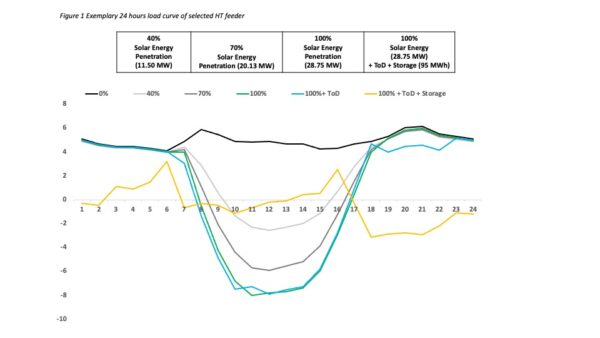
Voltage improvements and reduction in distribution losses
Distributed solar energy interconnected to existing HT feeders substantially improves voltage profiles and reduces distribution losses. Under the current scenario, without interventions (business-as-usual case), one selected feeder exceeds the permissible voltage band for 87% of the annual operation hours. After the introduction of distributed solar energy, the instances of voltage violation are dramatically improved. Under the 100% solar energy, ToD tariffs and energy storage scenario, voltage violations reduce from 80% to less than 1% of the annual operation hours (refer to Figure 2).
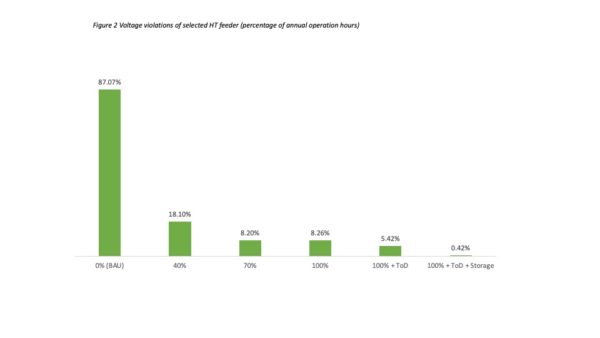
Solar energy penetration levels of 40% and 70% show improvements in distribution losses over business-as-usual scenario. While the distribution losses increase with 100% solar energy, as net energy flow increases, the addition of ToD tariffs and energy storage is able to reduce distribution losses from a 18.44% to a 5.78% (refer to Figure 3).
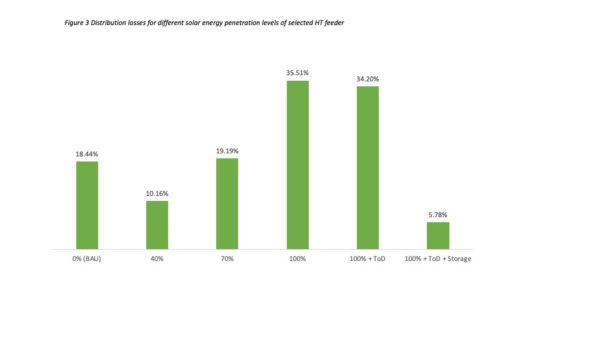
Financial benefits
For the selected feeder, the utility is currently making an annual loss of INR 15.66 crore on the supply of electricity to its consumers. Its cost of supply is higher than the revenue collected through electricity billing. The introduction of distributed solar energy, ToD tariffs and energy storage can reduce this revenue gap by INR 9.75 crore from a 15.66 Crore in the business-as-usual case to INR 5.91 crore for 100% solar, ToD tariffs and energy storage (refer to Table 1). These financial benefits are expected to increase over time, as the levelized cost of solar and energy storage is assumed to be fixed over the contract period, whereas both the cost of grid supply and consumer tariffs are expected to increase by at least the average inflation rate.
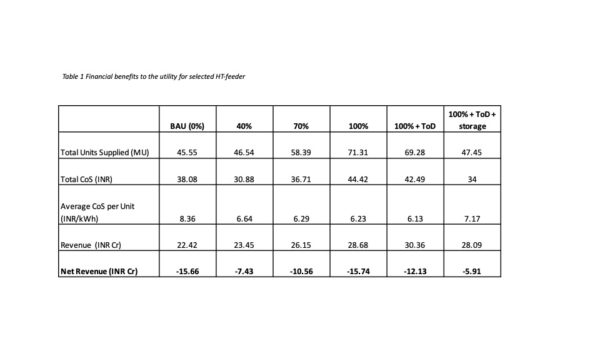
Solar energy, ToD tariffs and energy storage–a winning proposition
In summary, distributed solar energy generation, in conjunction with well-designed ToD tariffs and energy storage, promises to be a winning proposition for utilities. The expected high-level technical and commercial benefits are:
- Improved voltage profiles and reduction in distribution and transmission losses.
- Avoided investments in dedicated power evacuation infrastructure through interconnection at existing distribution network nodes.
- ToD tariffs facilitate higher local consumption of solar energy, reduce distribution losses and increase revenue.
- Distributed solar energy, with or without energy storage, reduces the total cost of supply and, therefore, improves utilities’ financial performance.
How do we move forward?
To accelerate the deployment of distributed solar energy generation and energy storage, utilities need to endorse such an approach. This will require more evidence. Pilot projects by forward-thinking developers or by the utilities will need to get off the ground.
To start with, utilities can simply identify feeders with low average tail-end voltages and prioritize these feeders for solarization. Eventually, utilities can take a proactive planning approach by identifying feeders that are expected to benefit the most from adding distributed solar energy generation and energy storage.
This requires feeder-wise hosting capacity studies and should result in maps that indicate available grid-interconnection points on existing feeders along with the solar energy and storage capacity required to achieve optimal technical and commercial results. These maps can then be made available to developers.
The results obtained clearly show the technical and commercial benefits of generating electricity close to the point of consumption. More importantly, the results indicated that 100% solar energy penetration, in energy terms, is not only possible but a winning proposition, especially so for the distribution companies.
The views and opinions expressed in this article are the author’s own, and do not necessarily reflect those held by pv magazine.
This content is protected by copyright and may not be reused. If you want to cooperate with us and would like to reuse some of our content, please contact: editors@pv-magazine.com.
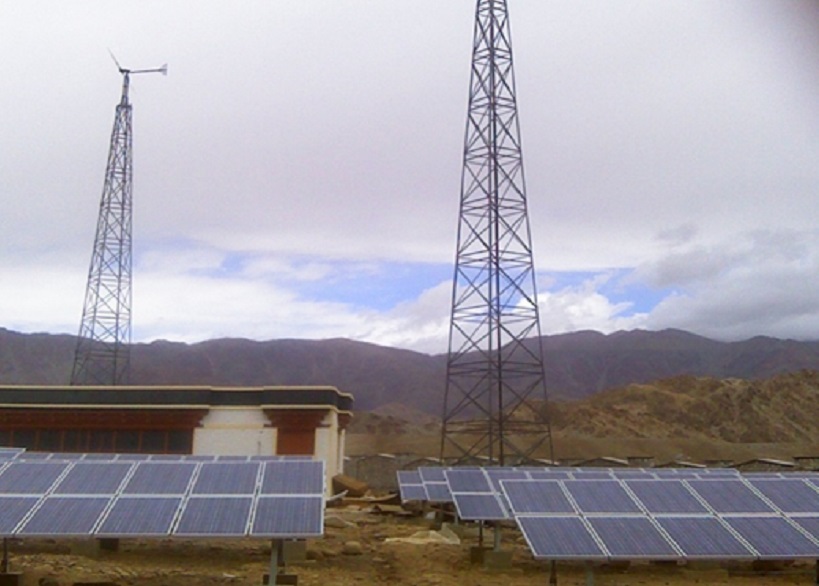







People ” thinking Solar” have to reorient their TOD Tariff “thinking” which were based on DAYTIME PEAKS… and start to understand that in a 100% Solar Grid meeting ALL Energy needs (not just Electricity customers) the Energy Storage Costs/Burdens of Sunset-to-Sunrise (S2S)…. would actually replace TOD by TON (Time of Night) Usage…. Yes… you first heard of it here….